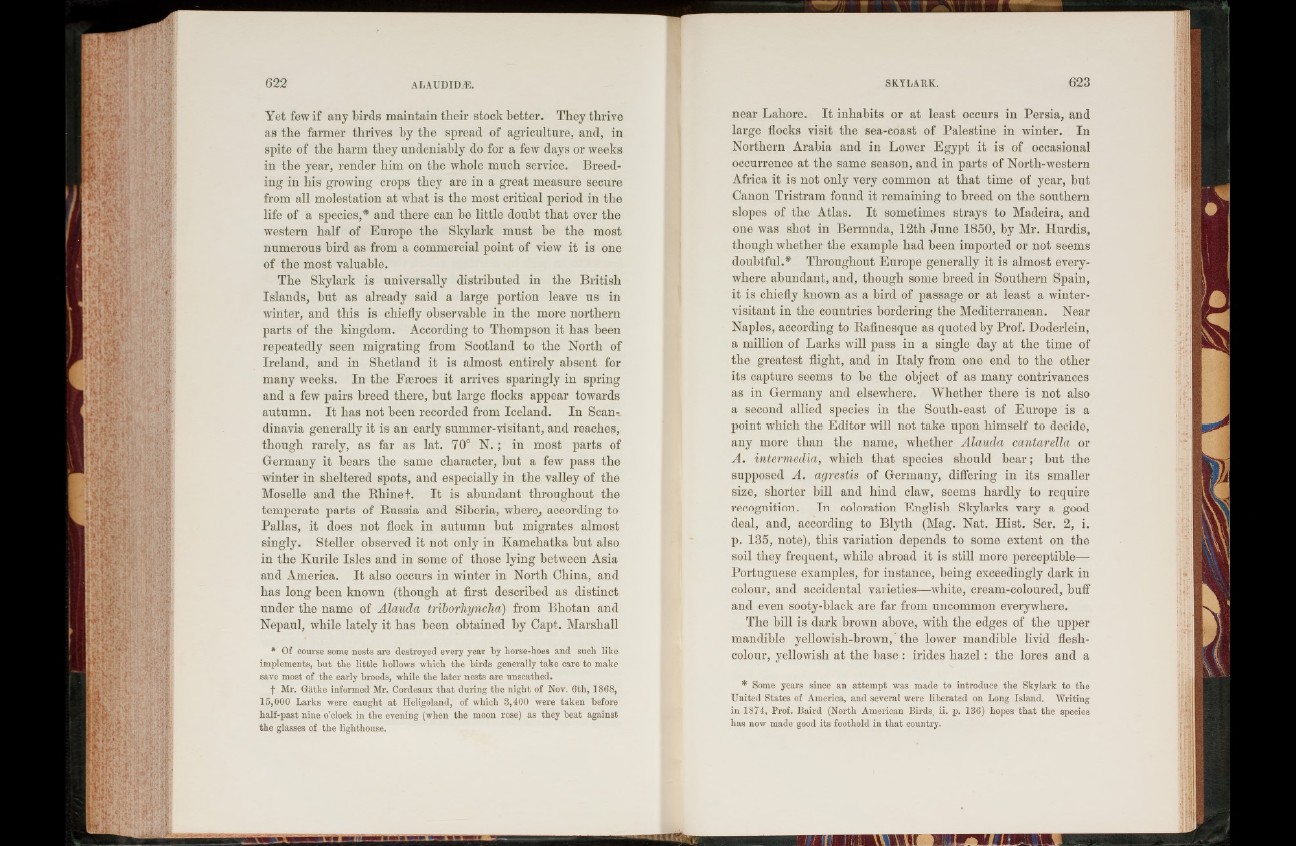
Yet few if any birds maintain their stock better. They thrive
as the farmer thrives by the spread of agriculture, and, in
spite of the harm they undeniably do for a few days or weeks
in the year, render him on the whole much service. Breeding
in his growing crops they are in a great measure secure
from all molestation at what is the most critical period in the
life of a species,* and there can be little doubt that over the
western half of Europe the Skylark must be the most
numerous bird as from a commercial point of view it is one
of the most valuable.
The Skylark is universally distributed in the British
Islands, but as already said a large portion leave us in
winter, and this is chiefly observable in the more northern
parts of the kingdom. According to Thompson it has been
repeatedly seen migrating from Scotland to the North of
Ireland, and in Shetland it is almost entirely absent for
many weeks. In the Faeroes it arrives sparingly in spring
and a few pairs breed there, but large flocks appear towards
autumn. I t has not been recorded from Iceland. In Scandinavia
generally it is an early summer-visitant, and reaches,
though rarely, as far as lat. 70° N . ; in most parts of
Germany it hears the same character, but a few pass the
winter in sheltered spots, and especially in the valley of the
Moselle and the Rhine t. I t is abundant throughout the
temperate parts of Russia and Siberia, where, according to
Pallas, it does not flock in autumn but migrates almost
singly. Steller observed it not only in Kamchatka but also
in the Kurile Isles and in some of those lying between Asia
and America. I t also occurs in winter in North China, and
has long been known (though at first described as distinct
under the name of Alauda triborhyncha) from Bhotan and
Nepaul, while lately it has been obtained by Capt. Marshall
* Of course some nests are destroyed every year by horse-hoes and such like
implements, but the little hollows which the birds generally take care to make
save most of the early broods, while the later nests are unscathed.
f Mr. Gatke informed Mr. Cordeaux that during the night of Nov. 6th, 1868,
15,000 Larks were caught a t Heligoland, of which 3,400 were taken before
half-past nine o’clock in the evening (when the moon rose) as they beat against
the glasses of the lighthouse.
near Lahore. I t inhabits or at least occurs in Persia, and
large flocks visit the sea-coast of Palestine in winter. In
Northern Arabia and in Lower Egypt it is of occasional
occurrence at the same season, and in parts of North-western
Africa it is not only very common at that time of year, but
Canon Tristram found it remaining to breed on the southern
slopes of the Atlas. It sometimes strays to Madeira, and
one was shot in Bermuda, 12th June 1850, by Mr. Hurdis,
though whether the example had been imported or not seems
doubtful.* Throughout Europe generally it is almost everywhere
abundant, and, though some breed in Southern Spain,
it is chiefly known as a bird of passage or at least a winter-
visitant in the countries bordering the Mediterranean. Near
Naples, according to Rafinesque as quoted by Prof. Doderlein,
a million of Larks will pass in a single day at the time of
the greatest flight, and in Italy from one end to the other
its capture seems to be the object of as many contrivances
as in Germany and elsewhere. Whether there is not also
a second allied species in the South-east of Europe is a
point which the Editor will not take upon himself to decide,
any more than the name, whether Alauda cantarella or
A. intermedia, which that species should bear; but the
supposed A. agrestis of Germany, differing in its smaller
size, shorter bill and hind claw, seems hardly to require
recognition. In coloration English Skylarks vary a good
deal, and, according to Blyth (Mag. Nat. Hist. Ser. 2, i.
p. 135, note), this variation depends to some extent on the
soil they frequent, while abroad it is still more perceptible—
Portuguese examples, for instance, being exceedingly dark in
colour, and accidental varieties—wdiite, cream-coloured, buff
and even sooty-black are far from uncommon everywhere.
The bill is dark brown above, with the edges of the upper
mandible yellowish-brown, 'th e lower mandible livid flesh-
colour, yellowish at the base : irides h a z e l: the lores and a
* Some years since an attempt was made to introduce the Skylark to the
United States of America, and several were liberated on Long Island. Writing
in 1874, Prof. Baird (North American Birds, ii. p. 136) hopes that the species
has now made good its foothold in that country.